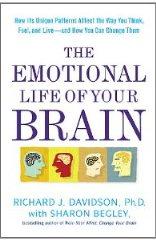The Emotional Life of Your Brain
In making those discoveries, I have found that, in contrast to the longstanding scientific orthodoxy, Emotional Style arises partly from activity in regions involved in cognition, reason, and logic—functions that textbooks tell us are as unrelated to emotions as apples are to squid. That has come as a shock to defenders of the view that cognition—which many psychologists and neuroscientists consider the most exalted human capacity—and emotion (viewed as a lesser, almost animalistic trait) run on separate, mutually independent brain circuitry: the former in the “highly evolved” frontal cortex and the latter in the limbic system, which in humans is not much different from that of other animals. In showing that cognition and emotion are not so separate after all, these discoveries have rehabilitated emotion. From a behavior that was, as recently as the 1970s, studied for the most part only in rats and other lab animals, human emotion has now assumed as important a place in neuroscience as thinking.
Locating the bases of emotion at least partly in the brain’s seat of reason has several practical implications. None is more intriguing than this: it is possible to transform your Emotional Style through systematic mental practice.
It is hard to exaggerate what a break this is from the conventional wisdom in psychology and neuroscience. From the earliest days of brain mapping—determining which regions are responsible for which functions—neuroscientists traced feelings and thoughts to structures that were barely within hailing distance of each other. The limbic system deep in the brain, including the amygdala and hippocampus, seemed to be the brain’s holy terror of a 2-year-old, the site of anger, fear, and anxiety, as well as positive emotions. The frontal cortex, just behind the forehead, was the exalted thinker, where forethought and judgment, reason and volition, attention and cognition came from. As recently as the 1980s, neuroscientists focused almost exclusively on cognition and the other functions of the frontal cortex; emotions were deemed of so little interest that neuroscience left them to psychology.
The first crack in this wall came in the 1980s. The neurobiology of emotion was still a backwater, but a few scientists were beginning to pay more attention to feelings, particularly in the context of depression. Inspired by one of them, I launched experiments using electrodes to measure brain activity in people whose emotional state we manipulated in the lab. By showing them upsetting, fearful, or uplifting videos and photos, for instance, and monitoring their response, we discovered that how well and how quickly a person is able to bounce back from adversity has nothing to do with activity in what scientists identify as the brain’s emotion centers. Instead, the ability to vanquish feelings of grief, anger, or other negative emotions reflects activity in the prefrontal cortex. In this research, we found that Resilience—one of the six elements of Emotional Style—is marked by greater left versus right activation in the prefrontal cortex: a lack of Resilience comes from higher right prefrontal activation. The amount of activation in the left prefrontal region of a Resilient person can be 30 times that in someone who is not Resilient.
by Richard J. Davidson, Ph.D., and Sharon Begley

